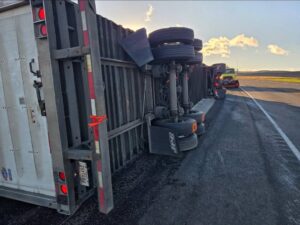WASHINGTON – During the last week of April, the U.S. Department of Transportation’s Federal Highway Administration (FHWA) observed the 50th anniversary of its National Bridge Inspection Standards (NBIS), the basis for the federal program that helps protect nearly 620,000 bridges across the country.
“For a half-century, NBIS standards have been at the core of federal infrastructure safety efforts,” said Acting Federal Highway Administrator Stephanie Pollack. “The data we collect under the program help keep bridges safe and identify areas where maintenance is needed before problems arise.”
The number of bridges in the NBIS program has grown from 588,735 to 618,456 — that’s nearly 30,000 new bridges — over the past 20 years, and the program has continued to ensure these bridges are safe for those who rely on the structures for travel and commerce.
The NBIS requires regular and thorough inspections of highway bridges by trained inspectors to detect potential structural problems early and to ensure maintenance efforts are being carried out. State departments of transportation inspect bridges, on average, once every 24 months and report the results to FHWA. If a bridge is rated as potentially unsafe, immediate actions are taken, which could include closure, prompt repairs or load posting to restrict use by heavy vehicles.
In addition to specialized training for bridge inspectors, the program also requires the collection of bridge condition data for inclusion in FHWA’s National Bridge Inventory (NBI), which helps transportation officials make informed decisions about funding priorities.
“The NBIS is vital to bridge safety in our nation,” Pollack added. “The (Biden) administration’s American Jobs Plan proposes significant investment in our nation’s bridges to continue improve their condition and make them even safer.”
FHWA officially adopted the NBIS regulations in 1971 after the collapse of the Silver Bridge in West Virginia. The bridge collapsed into the Ohio River in 1967 because of a crack in the bridge’s suspension chain. The tragedy, which cost the lives of 46 people, brought national attention to the issue of bridge condition safety and led to a systematic effort to ensure oversight at the national level.
Since the program’s inception, FHWA has worked to update training requirements for bridge inspectors and replace narrative bridge inspection summaries with specific assessment criteria to improve consistency.
According to a statement from the FHWA, President Joe Biden’s American Jobs Plan would provide an additional $115 billion to modernize the bridges, highways, roads, and main streets that are in most critical need of repair. It will fix 10 significant bridges in need of reconstruction and repair the worst 10,000 smaller bridges to reconnect communities across the country.
The Trucker News Staff produces engaging content for not only TheTrucker.com, but also The Trucker Newspaper, which has been serving the trucking industry for more than 30 years. With a focus on drivers, the Trucker News Staff aims to provide relevant, objective content pertaining to the trucking segment of the transportation industry. The Trucker News Staff is based in Little Rock, Arkansas.















